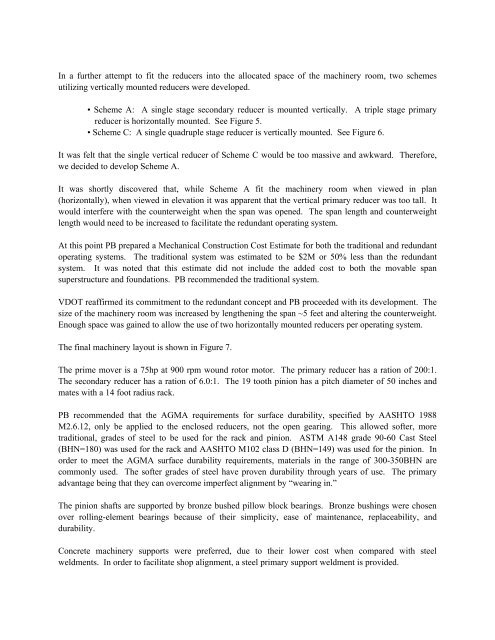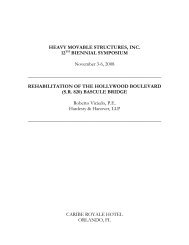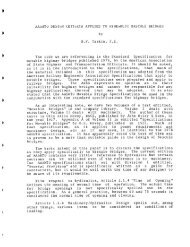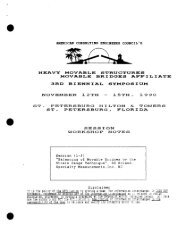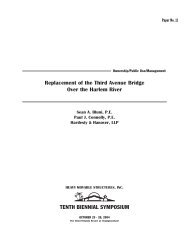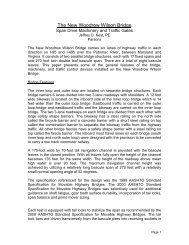Route 33 Over Pamunkey River, West Point, VA - Heavy Movable ...
Route 33 Over Pamunkey River, West Point, VA - Heavy Movable ...
Route 33 Over Pamunkey River, West Point, VA - Heavy Movable ...
- No tags were found...
Create successful ePaper yourself
Turn your PDF publications into a flip-book with our unique Google optimized e-Paper software.
In a further attempt to fit the reducers into the allocated space of the machinery room, two schemesutilizing vertically mounted reducers were developed.• Scheme A: A single stage secondary reducer is mounted vertically. A triple stage primaryreducer is horizontally mounted. See Figure 5.• Scheme C: A single quadruple stage reducer is vertically mounted. See Figure 6.It was felt that the single vertical reducer of Scheme C would be too massive and awkward. Therefore,we decided to develop Scheme A.It was shortly discovered that, while Scheme A fit the machinery room when viewed in plan(horizontally), when viewed in elevation it was apparent that the vertical primary reducer was too tall. Itwould interfere with the counterweight when the span was opened. The span length and counterweightlength would need to be increased to facilitate the redundant operating system.At this point PB prepared a Mechanical Construction Cost Estimate for both the traditional and redundantoperating systems. The traditional system was estimated to be $2M or 50% less than the redundantsystem. It was noted that this estimate did not include the added cost to both the movable spansuperstructure and foundations. PB recommended the traditional system.VDOT reaffirmed its commitment to the redundant concept and PB proceeded with its development. Thesize of the machinery room was increased by lengthening the span ~5 feet and altering the counterweight.Enough space was gained to allow the use of two horizontally mounted reducers per operating system.The final machinery layout is shown in Figure 7.The prime mover is a 75hp at 900 rpm wound rotor motor. The primary reducer has a ration of 200:1.The secondary reducer has a ration of 6.0:1. The 19 tooth pinion has a pitch diameter of 50 inches andmates with a 14 foot radius rack.PB recommended that the AGMA requirements for surface durability, specified by AASHTO 1988M2.6.12, only be applied to the enclosed reducers, not the open gearing. This allowed softer, moretraditional, grades of steel to be used for the rack and pinion. ASTM A148 grade 90-60 Cast Steel(BHN=180) was used for the rack and AASHTO M102 class D (BHN=149) was used for the pinion. Inorder to meet the AGMA surface durability requirements, materials in the range of 300-350BHN arecommonly used. The softer grades of steel have proven durability through years of use. The primaryadvantage being that they can overcome imperfect alignment by “wearing in.”The pinion shafts are supported by bronze bushed pillow block bearings. Bronze bushings were chosenover rolling-element bearings because of their simplicity, ease of maintenance, replaceability, anddurability.Concrete machinery supports were preferred, due to their lower cost when compared with steelweldments. In order to facilitate shop alignment, a steel primary support weldment is provided.


